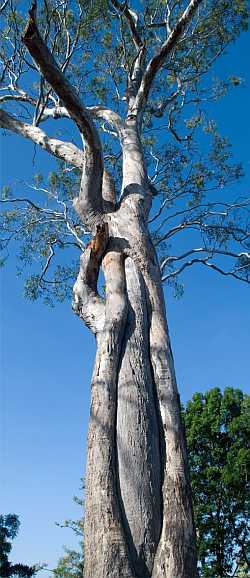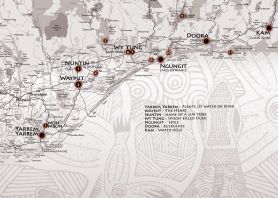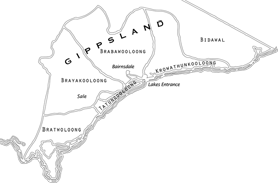
Bataluk Cultural Trail
Aspects of Koorie Life.
Scarred trees
 Scarred trees occurred when Aboriginal people, the Gunaikurnai, removed a slab of bark from a tree for various reasons such as to make bark canoes, shields, infant carriers, bowls and gunyahs (bark huts). Toe holds were cut into trees to make them easier to climb. This enabled the climber to reach higher in the trees to use them for look-outs and to hunt possums or collect bee hives.
Scarred trees occurred when Aboriginal people, the Gunaikurnai, removed a slab of bark from a tree for various reasons such as to make bark canoes, shields, infant carriers, bowls and gunyahs (bark huts). Toe holds were cut into trees to make them easier to climb. This enabled the climber to reach higher in the trees to use them for look-outs and to hunt possums or collect bee hives.
To remove the bark the Aboriginal people would use stone axes to cut an outline of the shape they wanted to remove. The bark was then levered off in one big piece. If the bark ever broke or was split it would be useless, so great care and skill was required. After the bark had been removed, the bark sheet would be heated over the fire to allow it to be easily shaped.
There is a high concentration of Koori sites in Gippsland.We ask that you treat all sites along the Trail with respect and care. Please remember it is an offence under the Heritage Act to tamper with or remove anything from any aboriginal site.
Maps


Contact
Krowathunkooloong Keeping PlaceGippsland and East Gippsland Aboriginal Co-operative 37 - 53 Dalmahoy Street
Bairnsdale
Tel: (03) 5152 1891
Visitor Information Centres Orbost (03) 5154 2424
Lakes Entrance (03) 5155 1966
Bairnsdale (03) 5152 3444
Maffra (03) 5141 1811
Sale 1800 677 520
Sites
- white woman's waterhole
won wron state reserve - the lagoon
sale common state game reserve - the knob reserve
stratford - ramahyuck cemetery
perry bridge - den of nargun
mitchell river national park - krowathunkooloong keeping place
bairnsdale - howitt park
bairnsdale - legend rock
metung - buchan caves
buchan - burnt bridge reserve
lake tyers forest park - salmon rock and gunai boardwalk
cape conran

Please treat all sites along the trail with respect and care to ensure they are preserved for future generations.
Development of the Bataluk Cultural trail is a joint initiative of the Far East Gippsland Aboriginal Corporation, Gippsland and East Gippsland Aboriginal Co-operative, Lake Tyers Aboriginal Trust, Moogji Aboriginal Council, Ramahyuck Aboriginal Corporation, East Gippsland Shire Council and Wellington Shire Council.